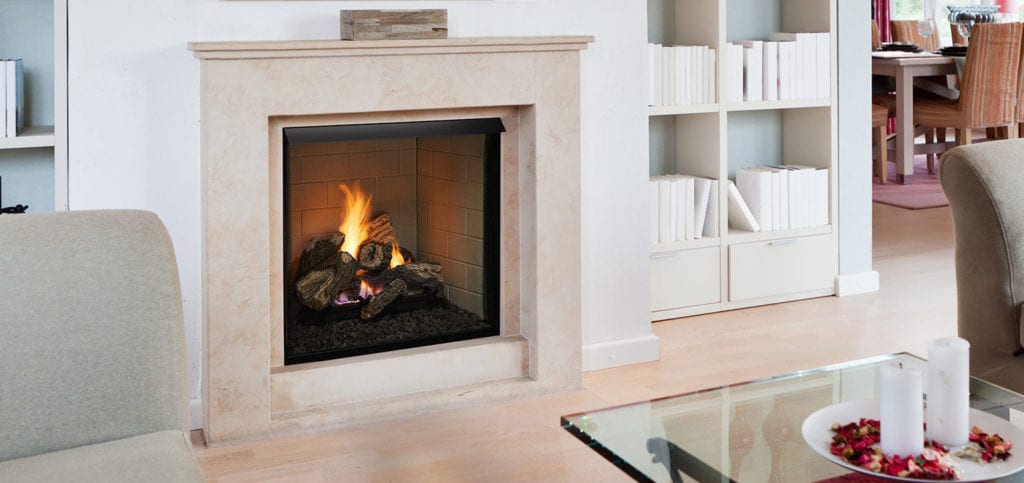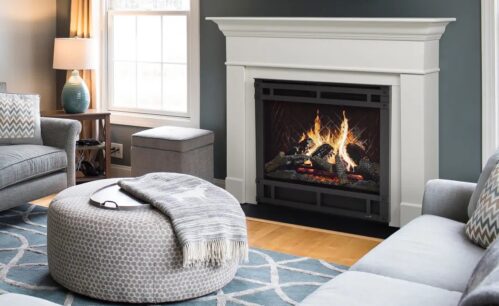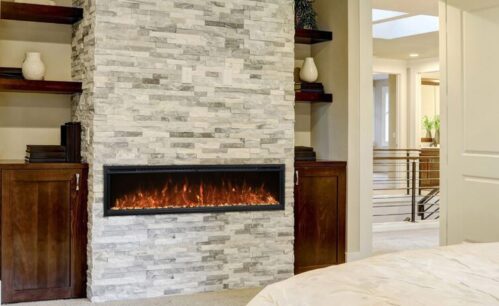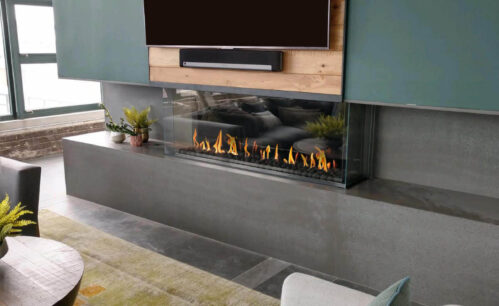Articles
Fireplaces | Frequently Asked Questions

What is the difference between vented and vent-free log fireplaces?
Vented logs require a fully functioning chimney to operate. The logs are often made of refractory cement and highly detailed, and the fire is full and reminiscent of a true wood-burning fire from an aesthetic standpoint. Vent-free logs provide a significant amount of heat and do not require a functioning chimney. However, the flame presentation is sparse and not as realistic.
What is the difference between an insert, logs, and a direct vent unit?
A fireplace insert most commonly refers to a prefabricated steel box, which is installed inside of an existing masonry fireplace. These use flexible venting, which is ideal for narrower clay flue chimneys. Direct vent fireplaces are similar in that they are also a prefabricated steel box, however they are meant to go into new construction framing. These instead use a rigid steel venting, which cannot be safely installed into an existing masonry chimney. Gas logs are a free standing burner and log system, which can be installed in either masonry or prefabricated wood burning fireplaces, as an alternative to burning wood.
How often should I have my fireplace serviced & cleaned? Is this something Hamilton Parker offers?
You should treat your fireplace similarly to how you treat your car – it’s important to operate it regularly to keep it running smoothly. Just like an annual tune-up, your fireplace will need annual maintenance and cleaning once a year. Hamilton Parker offers this service, which includes us not only cleaning and prepping your fireplace for the winter, but ensuring everything is operating safely and correctly.
Can I add a blower to my fireplace?
Depending on the model of your fireplace, a blower may or may not be an optional accessory. Only a few wood-burning fireplaces have the capability to add one, whereas a majority of direct vent gas fireplaces will either come with one or have it as an optional accessory. It’s important to remember that a blower is meant to supplement the heat output of your fireplace, not increase it.
What does Hamilton Parker installation include?
Hamilton Parker’s installation service typically breaks down into two separate visits. The first includes the setting and installation of the fireplace box and any venting that it may require. The second will include installing any accessories (gas logs, media, decorative fronts, glass, etc.) and firing the fireplace up. Any plumbing, electrical, framing or demolition work will be completed by your contractor, prior to installation
Is it safe to put a television above my fireplace?
Many fireplace manufacturers do offer solutions to make it safer, but remember that fireplaces do produce heat, and heat and electronics often don’t mix. If you plan to install a TV above your fireplace, make sure you have a mantel or shelf to help deflect heat, or opt to use a fireplace that offers cool wall kits, or similar technology, to keep the wall cool and your TV safe.
What is over-firing? How can I avoid this? What type of wood should I burn in my prefab fireplace?
Over-firing is when the fire is built inside a prefabricated steel box are too large and too hot. Often, as a result, the brick panels on the sides and back of the fireplace will begin to deteriorate and crumble. This is because they are not able to withstand the size of the fires being built and the heat output they are creating. To avoid this, always be sure to follow the instructions in your fireplace owner’s manual in regards to building a fire properly. Wood should always be dry and untreated when used for burning.
Can I use (Natural Gas or Liquid Propane) with this unit?
Any gas fireplace will have the capability to operate with either natural gas or propane. It’s important to know which you are using before ordering your fireplace, as some models cannot be converted from one fuel source to the other.
Why does/doesn’t my fireplace have glass? Do I have to have it/can I add it?
Fireplaces with fixed glass fronts are called Direct Vent and require the glass be affixed in order to operate. Wood burning fireplaces may or may not have operable glass doors, however they cannot be shut when burning wood or operating gas logs.
Why does my wood burning fireplace have so much cold air infiltration? What can I do?
Wood burning fireplaces have two common sources for cold air infiltration: the damper and the fresh air intake. To alleviate this, always make sure the damper is fully shut after you finish burning your fires. Additionally, there are levers inside your fireplace to adjust the shutters on your fresh air intake, which you can adjust as needed.
What is HP’s warranty?
Hamilton Parker’s warranty covers parts and labor for installs up to one year after the completion date. Manufacturer warranties will vary by product.


